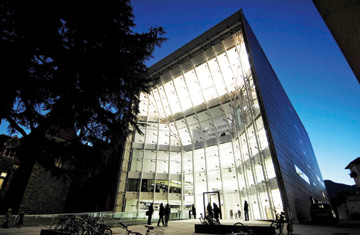
FULL EXPOSURE: The museum's glass façade
Situated in south Tyrol, the German-speaking region of northern Italy, the sleepy town of Bolzano is best known for its breathtaking views of the Dolomites. But after seven years of planning and a $48 million investment by province officials, it may soon be known for its architecture, too.
Last month, Bolzano's Museum of Modern and Contemporary Art moved into its new home — a simple yet stunning 82-ft. (25 m) tall cube. Its aluminum-clad sides contrast sharply with the stone exteriors that prevail in the region, but appear organic at the same time: their metallic sheen seems to emerge from the mountainous, snow-capped skyline. More striking are the museum's plate-glass front and rear façades, which expose the core of the building to the outside world while bringing in the landscape. During the day, curators modulate the glass paneling to direct sunlight into specific exhibition spaces. And at night they transform the walls into giant canvases by projecting specially commissioned artwork onto them.
When designing the museum, German architecture firm Krüger Schuberth Vandreike drew inspiration from Paris' Pompidou Center, and so its four levels do not feature any permanent interior walls, allowing the exhibition space to evolve. To reach the museum, visitors must traverse one of two bridges that curve horizontally and vertically over the Talvera River. The suggestion is that they are entering new territory. Given the building's grand vision, perhaps they are. www.museion.it